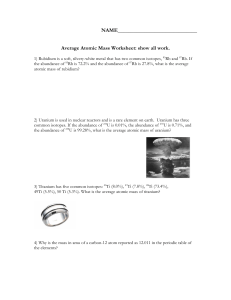

Follow along and record the measurements to get the relative masses. Steve Boon shows how Avogadro's hypothesis can be used to measure the molecular masses of He, N 2 and CO2. The important point is that 1 mol of carbon-or of anything else, whether atoms, compact discs, or houses-always has the same number of objects: 6.022 × 10 23. The definition of a mole-that is, the decision to base it on 12 g of carbon-12-is arbitrary but one arrived at after some discussion between chemists and physicists debating about whether to use naturally occurring carbon, a mixture of C-12 and C-13, or hydrogen. Avogadro's number is the fundamental constant that is least accurately determined. A mole of C-12 by definition weighs exactly 12 g and Avogadro's number is determined by counting the number of atoms. The numerical value of Avogadro's number, usually written as No, is a consequence of the arbitrary value of one kilogram, a block of Pt-Ir metal called the International Prototype Kilogram, and the choice of reference for the atomic mass unit scale, one atom of carbon-12. It allows determination of the number of molecules or atoms by weighing them. The mole provides a bridge between the atomic world (amu) and the laboratory (grams). Since the mass of the gas can also be measured on a sensitive balance, knowing both the number of molecules and their total mass allows us to simply determine the mass of a single molecule in grams.

#AVERAGE ATOMIC MASS PROBLEMS WORKSHEET HOW TO#
The number in a mole is called Avogadro’s number : 6.022142 x 10 23, after the 19th-century Italian scientist who first proposed how to measure the number of molecules in a gas. Just as 1 mol of atoms contains 6.022 × 10 23 atoms, 1 mol of eggs contains 6.022 × 10 23 eggs. According to the most recent experimental measurements, this mass of carbon-12 contains 6.022142 × 10 23 atoms, but for most purposes 6.022 × 10 23 provides an adequate number of significant figures.

The mole is used for this purpose.Ī mole is defined as the amount of a substance that contains the number of carbon atoms in exactly 12 g of isotopically pure carbon-12. Any readily measurable mass of an element or compound contains an extraordinarily large number of atoms, molecules, or ions, so an extraordinarily large numerical unit is needed to count them. Atoms are so small, however, that even 500 atoms are too small to see or measure by most common techniques. Sheets of printer paper are packaged in reams of 500, a seemingly large number. For example, cans of soda come in a six-pack, eggs are sold by the dozen (12), and pencils often come in a gross (12 dozen, or 144). Many familiar items are sold in numerical quantities that have unusual names. The quantity of a substance that contains the same number of units (e.g., atoms or molecules) as the number of carbon atoms in exactly 12 g of isotopically pure carbon-12., from the Latin moles, meaning “pile” or “heap” ( not from the small subterranean animal!). The unit that provides this link is the mole (mol). To analyze the transformations that occur between individual atoms or molecules in a chemical reaction it is therefore absolutely essential for chemists to know how many atoms or molecules are contained in a measurable quantity in the laboratory-a given mass of sample. In the laboratory, for example, the masses of compounds and elements used by chemists typically range from milligrams to grams, while in industry, chemicals are bought and sold in kilograms and tons. Because the masses of individual atoms are so minuscule (on the order of 10 −23 g/atom), chemists do not measure the mass of individual atoms or molecules. The problem for Dalton and other early chemists was to discover the quantitative relationship between the number of atoms in a chemical substance and its mass.
#AVERAGE ATOMIC MASS PROBLEMS WORKSHEET SERIES#
We also described the law of multiple proportions, which states that the ratios of the masses of elements that form a series of compounds are small whole numbers. In Dalton’s theory each chemical compound has a particular combination of atoms and that the ratios of the numbers of atoms of the elements present are usually small whole numbers. The same calculation can also be done in a tabular format, which is especially helpful for more complex molecules:


 0 kommentar(er)
0 kommentar(er)
